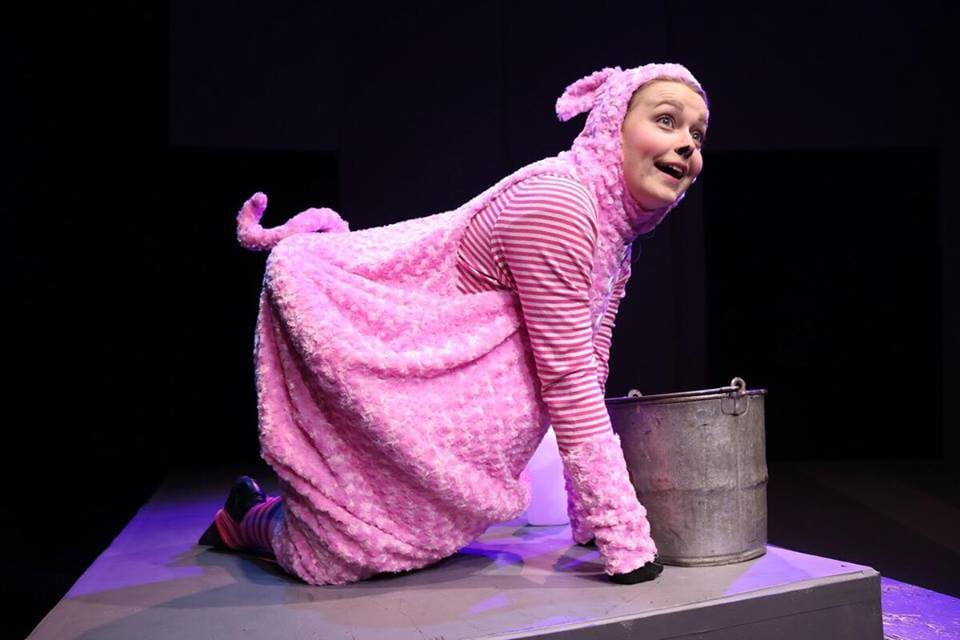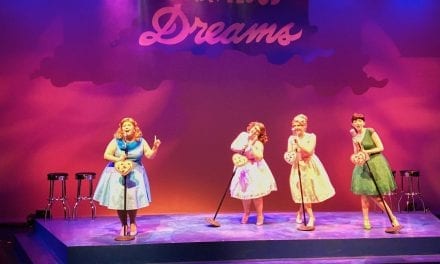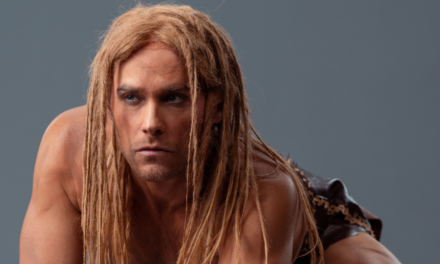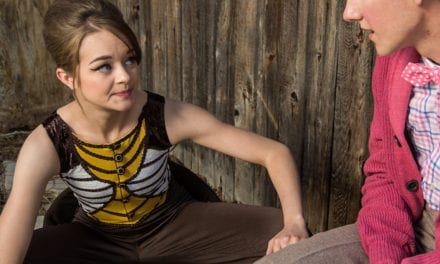SOUTH SALT LAKE — Charlotte’s Web by E.B. White is a classic children’s story for good reason: it is both heartwarming and heart-wrenching. It is the story of Wilbur, a pig who realizes he’s being fattened up to be eaten, and his friend Charlotte, a clever spider who develops a plan to save Wilbur’s life. The story deals with difficult topics like death in a manner that is well suited for children. Utah Children’s Theatre and director Emily Holmgren have done well at recreating this beloved classic.

Show closes February 23, 2019.
Larissa Anderson did well in her portrayal as Wilbur. Her facial expressions added to the scenes where Wilbur does not speak much. My child particularly enjoyed when Wilbur decides that his best option to save himself from an untimely death is to run away. A mad chase scene with Wilbur being pursued all over the stage and through the audience had the children around me riotously laughing. When Wilbur is finally waylaid by the geese and goslings he deems them traitors. This fun, high energy moment contrasted nicely to the scene where Wilbur is forced to leave a dying Charlotte at the fair grounds. This tender and sweet scene left my preschooler snuggled in my lap. I also loved how Wilbur recognizes that he was only focused on his own life while Charlotte had so lovingly sacrificed herself to save him. Anderson did well at showing Wilbur’s growing self-awareness.
Amanda Van Orden beautifully played Charlotte. Charlotte presented herself with grace and compassion despite being a “blood thirsty” spider. Her dancing during the web-spinning scenes added the scenes’ magic. I liked that Charlotte had a sense of humor and that even as she was nearing the end of her life, she could still smile at the ridiculousness of Templeton’s actions.
I struggled at first with Emerson Mace’s rendition of Fern. I enjoyed Mace’s enthusiasm but occasionally felt that her character was stuck in one melodramatic gear. The melodrama worked well in a few scenes, especially in Fern’s description of riding the Ferris wheel with Henry Fussy, but in the scene where Fern’s father is heading to kill the runty piglet, the melodrama took away from the honesty of the scene. Fern seemed a bit young for Mace, especially in the beginning where a small doll buggy made Mace appear older than she really is. By the end of the production, Fern had caught up to Mace’s age. Earlier young Fern wasn’t interested in Henry Fussy, but later her cute waves and faces she gave him at the fair made me smile and laugh.
This production was solidly supported by the ensemble and other principle characters. The moment when spectators go moving across the barn entrance, all shuffling perfectly together and snapping photos, was a real golden nugget of the show. The goose (Meighan Smith), Gander (Grant Christopherson), and Templeton (Bryson Dumas) added wonderful humor to the production. I was also impressed with the performances of Trayven Call, who played the old Sheep and Uncle. His characters were so different that I didn’t initially realize he was both characters. His vocalizations for both animals enriched the characters. During the drive home, my preschooler couldn’t stop talking about the BIG pig, Uncle. She laughed every time she thought of him. The conceited pig was just as disgusting as expected.

Larissa Anderson as Wilbur and Amanda Van Orden as Charlotte.
The costume design by Julie Anderson was “terrific, terrific, terrific,” especially the goose and gander costumes. Their tall goose headpieces and big, yellow flippered feet added to the comedy of their characters while the ruffs around their neck added to their self-importance. When the geese chase Avery (Henry Holmgren) to keep him away from Charlotte, the costume helped Smith (Goose) and Christopherson (Gander) be as intimidating as real geese. The experience of being threatened by a large, hissing goose is unforgettable: the goose stretches up its long white neck, throws out its huge white wings, and on rubbery orange legs pursues the threat with its hard, snapping orange beak. With all the honking, hissing, and flapping chaos of these farm monsters, it’s easy to understand why anyone would fumble and flee, just as Avery does from Goose and Gander.
The makeup design by Smith was simple and effective. The animals had makeup that was more exaggerated, such as the pink circles on Wilbur’s cheeks and nose, which worked well. The animal makeup was simple enough to let the facial expressions come through while setting them apart from the human characters. However, the circular pink of Fern’s cheeks was inconsistent, making her stand out as the only non-animal character with distinct, non-blended cheeks. While the makeup tied her to Wilbur who had similar cheeks, it was distracting.
The set design and light design by James B. Parker was perfect for this production. The two designs worked beautifully together during the sunrise scenes where the light crept through the slats of the simple two-level barn and moved across the floor. The light design also added illustration and movement during the web-weaving scenes with projected spider webs twirling around the barn as Charlotte danced and weaved. When Charlotte became tired and weaker during her weaving towards the end of the play, the amount of projected webs decreased and the movement slowed. Good light design adds so much to a production, and Parker is an excellent and artistic designer who did just that.
The seating in Utah Children’s Theatre is a first come, first serve basis, so I like to arrive early enough to get a good seat. The interactive pre-show made the wait part of the experience and helped warm up my preschooler to the show as we waited, so I’d suggest arriving early to catch the fun. I thought that my preschooler might struggle with sitting through the 1 hour 45 minute run time (including the 15 minute intermission), but she was so well entertained it was not a problem. Because this production balances the seriousness and the fun well, my preschooler enjoyed it immensely and I had a pleasant experience. I’d definitely recommend Charlotte’s Web as a fun outing with the kids or grandkids.





